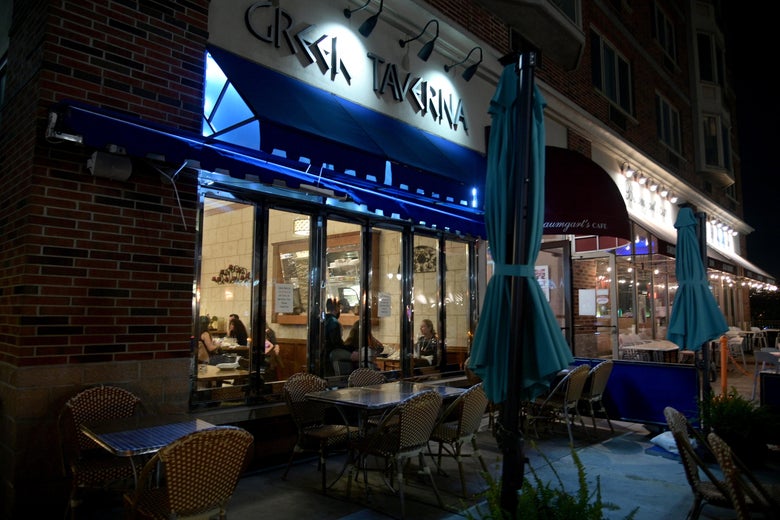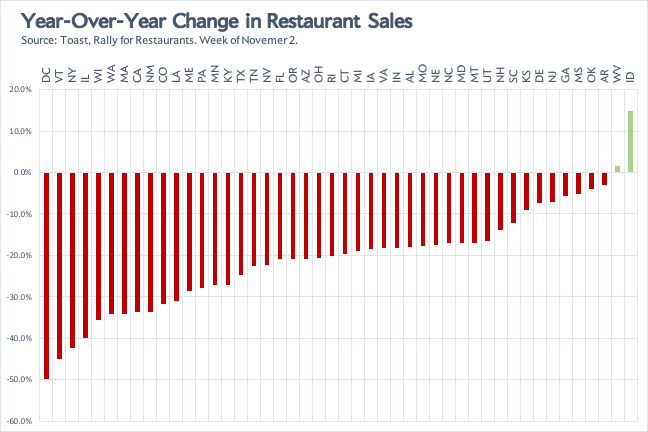
America’s approach to dealing with the coronavirus crisis is maddeningly backward.
For many months now, it has been obvious that the disease spreads most easily in poorly ventilated, indoor spaces where people talk and shout without masks, such as restaurants and bars. At the same time, it has also become evident that, with basic precautions, students can return to school more or less safely, allowing their parents to focus on their jobs, as long as the overall amount of community transmission is kept sufficiently low.
Given this set of facts, the logical public-health response seems clear. The government should close down indoor dining and drinking to slow infection rates, so that kids can go back to class while their parents work. Meanwhile, it should give bar and restaurant owners money to keep paying their staff and cover losses, to prevent business failures and unemployment from spiking.
This is precisely the strategy that Germany is now pursuing in response to its recent wave of COVID-19 cases. Some local authorities in the U.S. are pursuing it as well; this week, San Francisco responded to an uptick in infections by announcing that it would shut down indoor dining once again, while still moving forward with plans to reopen middle and elementary schools.
But for the most part, Americans have taken the opposite approach: As a nation, we have collectively decided to keep the bars open, even if it means keeping classrooms closed. Cities and states have largely allowed indoor dining and drinking to resume, which has helped fuel the horrific autumn coronavirus wave that’s overtaken the country. While the pandemic rages on, children in much of the country are stuck grinding through days of remote learning while their parents lose their minds trying to pull double duty on work and child care (that is, if they don’t give up on work entirely). The arrangement also seems to be exacerbating gaps between wealthy students, who have all the resources they need to learn at home, and poorer ones, who often don’t.
The reasons why we’ve chosen this absurd path are clear enough. In Trumpier parts of the country, many voters and most politicians would prefer to ignore the virus and try to live life as normal, even if it puts grandma in mortal danger. In more cautious blue states and cities, governors and mayors are clearly worried about the pandemic. But they also face powerful incentives to let businesses stay open for the sake of the local economy. Shutting down indoor dining might be the right public-health move, but it would cost jobs and put many establishments out of business while also depriving local governments of sales tax revenue. On schools, the political pressure pushes in the opposite direction: Teachers unions understandably prefer to keep classes shut if there’s a chance that in-person instruction won’t be safe for their members.
And so we find ourselves in situations like the one unfolding in New York City. With transmission rising, Mayor Bill de Blasio is on the verge of closing down in-person instruction entirely in the city’s schools, even though the actual infection rate among students and staff is fairly low. As for bars and restaurants? Gov. Andrew Cuomo has imposed a 10 p.m. curfew for them, but they’re still allowed to welcome diners inside.
You might think this status quo was at least working all right for the restaurant industry. But you’d largely be wrong. The hospitality business seems to have bounced back in a handful of states, such as Georgia. But in most places it’s limping along. According to point-of-sale system provider Toast, for instance, revenues were down 30 percent year over year at restaurants in its network last week. They’ve declined by 20 percent or more in states such as Ohio, Arizona, Florida, Tennessee, Texas, Kentucky, Louisiana, New York, and Pennsylvania.

Data from online booking site OpenTable tell a similar story of widespread trouble. On Saturday, the restaurants on its platform seated 28 percent fewer diners in Florida, 27 percent fewer in Kentucky, 38 percent fewer in Missouri, 50 percent fewer in New York, and 18 percent fewer in Texas (those numbers include both reservations and walk-ins). Meanwhile, many establishments are still shut down entirely. According to the marketing software firm Womply, which tracks credit and debit transactions at millions of small businesses, about a quarter of restaurants and a third of bars appear to be at least temporarily closed. Many of them might be gone for good. (Womply considers a business shuttered if it hasn’t run a card in three consecutive days.)
Rather than let America’s diners and dives struggle to stay in business, and turn themselves in COVID hot spots in the process, Congress should help them go into hibernation. Washington’s next relief package needs to provide money for restaurants and bars so that they can keep their dining rooms closed during the winter, while continuing to pay their staff and their bills. This approach makes even more sense than it did earlier this year, since we now appear to be on the verge of having a vaccine. With a medical answer to COVID on the horizon, the country doesn’t have to worry about supporting businesses indefinitely. Better yet, by reducing infection rates now, a temporary shutdown is guaranteed to save lives, rather than just delay cases until later.
And if Congress doesn’t act? Then more cities may need to follow San Francisco’s lead and shut bars and restaurants down—at least their indoor portions—even without financial aid. If people want to go out for a holiday drink, they should probably have to do it under a heat lamp.
"Shut" - Google News
November 13, 2020 at 05:54AM
https://ift.tt/32F6OKw
Shut Down and Bail Out the Bars. Shut Down and Bail Out the Bars. - Slate
"Shut" - Google News
https://ift.tt/3d35Me0
https://ift.tt/2WkO13c
Bagikan Berita Ini















Dewa HOKI lagi ada di pihak mu lo segera daftar dan bermain di DEWALOTTO kemenangan nyata menanti anda semua lo segera merapat ya guyss... :D
ReplyDeleteADD WA +855 888765575 Terima Kasih admint...:)